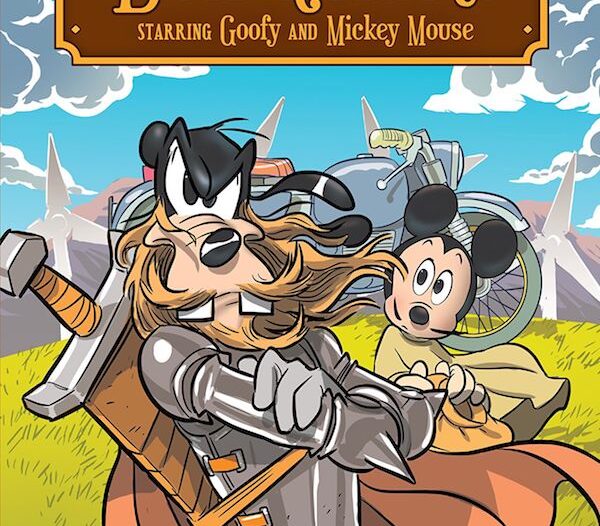
Review: ‘Disney Don Quixote’

Disney Don Quixote
Writer: Fausto Vitaliano
Artist: Claudio Sciarrone
Dark Horse Books; $10.99
Ages 8 and up
Disney Don Quixote is part of a new line of classic literature adaptations featuring Disney stars in the lead roles, originally created by European cartoonists, and newly translated and repackaged for North American audiences by Dark Horse. This latest installment follows Disney Treasure Island starring Mickey Mouse, while Hamlet and Frankenstein starring Donald Duck and Dracula starring Mickey Mouse are all in the pipeline.
It’s not quite as straightforward as, say, casting Mickey, Goofy, and friends as if they were actors playing the parts in a mostly faithful adaptation, tweaked to include jokes, parody, character-specific gags, and child-friendly narrative shortcuts, as in the 1983 animated offering Mickey’s Christmas Carol, a pretty good go-to of a Disney cartoon characters/classic literature mash-up.
ADVERTISEMENT
ADVERTISEMENT
And so Goofy does not play Alonso Quixano/Don Quixote and Mickey does not play Sancho Panza, but rather they play new and different versions of Goofy and Mickey, who experience a plot not completely unlike the one that the characters in Miguel de Cervantes’ 16th century novel did, making for an even more complicated adaptation of what would have been a pretty complicated adaptation regardless.
The book is set in Ciudad de Esmeralda, where Goofy and Mickey own and operate Historia y Historietas, “the first comic store in the whole country!” While Mickey is enamored with the books and their heroes and stories, Goofy only cares about the business side of the comic book retail business (“I might not be a fan of comics, but I’m very happy when we sell so many!” he says to Mickey as they knock off for lunch). Eventually Mickey finds a comic book that Goofy is willing to try reading, Don Alonso De Gascuna y Aragon, about a medieval knight who protects the world from terrible giants. In this adaptation, then, comic books replace the chivalric romances that Cervantes’ Alonso Quixano was so enamored of that he eventually began imitating them.
A crate of unsold copies of the book fall atop Goofy’s head, and when he stands up he starts calling Mickey Mouse “Sancho Mouse” and refers to himself as “Don Goofote of Castilla”. At the recommendation of a doctor, Mickey plays along with Goofy’s blow-to-the-head-induced delusions so as not to further hurt his friend’s mental state, and some of the best known scenes of Cervantes’ Don Quixote are kinda sorta recreated in a modern setting.
The pair take off on Goofy’s motorcycle with a sidecar, which Don Goofote now believes to be a valiant steed. They visit Clarabelle’s restaurant and an amusement park, which take the place of the inn. They fight windmills, but these are the sleek, white, modern ones that harness wind power for electricity. And so on.
ADVERTISEMENT
ADVERTISEMENT
The goings-on in Goofy’s imagination are rendered in black and white linework atop sepia-toned pages, and these more or less resemble a more “straight” adaptation of Don Quixote, with our two heroes looking as they do on the cover, while much of the rest of the comic is fully colored. There’s an additional trick when we see the pages of comics that Mickey or Goofy read, as these are colored so as to imitate the coloring techniques of classic comic books.
While Goofy drifts in and out of his imagination, real danger rears its head in their real world, and it is more akin to something out of comic books. Pete is the bullying lawman of our heroes’ small town, in the employ of a governor who turns out to be…a space alien bent on world conquest. The would-be conqueror has the ability to turn windmills into real giants, among other forms of high-tech weaponry. It will take the courage of a comic book store owner who thinks he’s a knight–plus a couple of two-by-fours–to save the world.
Some of the basic themes of the original are there, but the effort put into making the story modern seems to displace pages that might otherwise have been devoted to telling more of the story, or telling it better. The result is that this isn’t so much an issue of Classics Illustrated drawn in Disney comics style with Mickey and the gang in the starring roles as it is an original Disney story quite heavily inspired by the classic.
It is quite well made though, and in reformatting it to a digest-sized, kid-friendly trade paperback, Dark Horse certainly seems to be meeting the expectations of young U.S. comics readers. (With a couple of mid-story recaps, it’s pretty clear the narrative was originally intended to be serialized.) It is also, at the very least, an introduction to the the work that inspired it–Don Quixote is never really explained or summarized, but there’s a nice, concise biography of Miguel de Cervantes on the last page–and that’s certainly not a bad thing for young readers to have available to them.
Filed under: Reviews
About J. Caleb Mozzocco
J. Caleb Mozzocco is a way-too-busy freelance writer who has written about comics for online and print venues for a rather long time now. He currently contributes to Comic Book Resources' Robot 6 blog and ComicsAlliance, and maintains his own daily-ish blog at EveryDayIsLikeWednesday.blogspot.com. He lives in northeast Ohio, where he works as a circulation clerk at a public library by day.
ADVERTISEMENT
ADVERTISEMENT
SLJ Blog Network
One Star Review, Guess Who? (#202)
This Q&A is Going Exactly As Planned: A Talk with Tao Nyeu About Her Latest Book
Parsing Religion in Public Schools
Take Five: LGBTQIA+ Middle Grade Novels
ADVERTISEMENT







